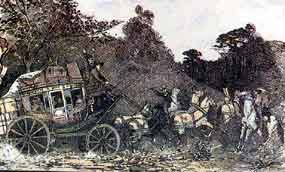|
People wanted to come to the hot springs as a treatment for ailments like rheumatism, or what we call arthritis today. There wasn't any television news or radio news or an Internet to spread the word, but people knew about the hot springs. How did they find out that the hot springs helped other people? They heard it from someone who had made the trip to the springs or from someone who knew someone. Sometimes the local newspaper would write an article about a visit. So how did people get to these hot springs to use the water before there were cars or airplanes? 
Carlsbad of America, 1893 Until railroads were built in the late 1800s, the sick people coming to the springs had to come part way by steamship and river boat, then overland by wagons or horseback and later stagecoach. After the Civil War, railroads extended through part of the way, but it was still an all day trip to get from the nearest rail line 26 miles away in Malvern, Arkansas, to Hot Springs. It was very hard on those who were sick or had joint problems like arthritis. Stagecoach travel could be dangerous: streams swelled when there was heavy rain, roads could wash out, or bandits sometimes held them up.
In 1878, wealthy Chicago businessman “Diamond” Joseph Reynolds decided to visit the hot springs to treat his rheumatism (the old name for arthritis). The trip was rough and the stagecoach even broke down. According to legend, the riders had to walk to a farm to spend the night while the coach was repaired. After that he declared he would build a railroad line so he and other sick visitors didn’t have to go through what he did. The narrow gage Hot Springs Rail Road was finished in 1875 and was often called the “Diamond Jo” line. The train coaches were made both comfortable and beautiful with rosewood and mahogany interiors, leather upholstery, silk curtains and velvet draperies. This rail line shortened the trip from Malvern to Hot Springs down to one hour.
This was the only rail service into Hot Springs for 25 years. The Hot Springs Rail Road line connected with the St. Louis, Iron Mountain & Southern Railroad. This company was the first to produce a booklet advertising Hot Springs and the baths. Published in 1877, “The Hot Springs of Arkansas, America’s Baden-Baden” included advertisements and a map of the railroad line. [Baden-Baden was a famous European spa.] Later other railroad lines followed suit and published their own guides, complete with descriptions and photographs of famous landmarks, hotels, and bathhouses. Eventually this narrow gage line was converted to a standard gage line in 1889. After this, wealthy Chicago visitors could ride their private Pullman cars all the way into Hot Springs. A second rail line was attempted in 1899 but not completed. The business was bought by Col. Samuel Fordyce, who also built the Cottonbelt Line in southeastern Arkansas, the Fordyce Bathhouse and other business ventures in his adopted town. The Little Rock & Hot Springs Western line connected from Memphis, Tennessee to Little Rock, Arkansas into Hot Springs and then into Texas.
After World War II, air travel became a popular way to travel and America was building super highways. The last train ran from Hot Springs in 1964. The old Missouri Pacific depot is still standing on Valley Street and is now used as the Hot Springs Transportation Depot. Today if you want to come to Hot Springs by train, the closest you can get is Little Rock or Malvern, Arkansas. Does it seem like we've made a circle?
|
Last updated: April 10, 2015
